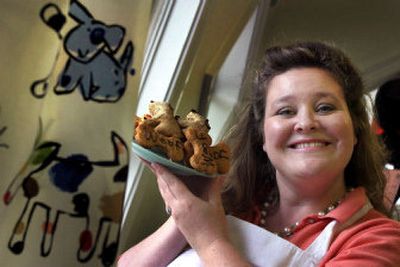Pets are luxury, says one

Sherry Shumaker has grooved to “Dancing Queen,” “Wild Thing” and “Doo Wah Diddy” with her dancing partner Heidi, a Doberman pinscher.
Heidi has taken lessons in standing on her hind legs, walking backward and spinning, all in time to music and in sync to Shumaker’s dance steps.
In addition to dance lessons, Shumaker, 43, a systems analyst, confesses to spending a “ridiculous” amount of money on her three dogs, giving them such luxuries as acupuncture therapy and organic food.
“I just wish I could use them as a tax deduction every year,” she said, laughing. “They’re worth every penny.”
Last year, pet owners across the country spent plenty of pennies – $34.4 billion – caring for their pets, more than double the $17 billion a year spent a decade earlier, according to American Pet Product Manufacturing Association Inc., a Greenwich, Conn.-based trade association. Much of that went for routine veterinary visits and over-the-counter food, but more owners are paying for toys, gourmet biscuits and a nice haircut. Cats outnumber dogs, but more of the money is going to the dogs.
“The owners are treating their pets more like family members,” said Robin Bennett, who owns All About Dogs Inc. in Woodbridge, Va. Her business specializes in obedience and agility training, including the freestyle dance class Shumaker takes her dog to.
Companies that once served only humans now consider their animal companions their customers. Paul Mitchell, Omaha Steaks and Harley-Davidson are among the companies extending their brands to pets by offering shampoos, treats and attire, respectively.
Rebecca Kalch carries brand-name pet clothing, leashes and collars at her Four Paws Bakery Inc. in Occoquan, Va. For example, there’s the Ruff Wear clothing line, including boots. “This is for the canine that’s going places,” said Kalch, who also sells polos to match an owner’s shirt.
Her bakery, which opened in November, makes Barkday and Bark Mitzvah cakes for those special occasions. Kalch is trying to get other boutique pet stores to carry her homemade treats – with names like Pupparoni and PNut-Butter Pudy-Tat’s – and pet meals.
Kalch is breaking even on her expenses and sales, which she didn’t expect to happen until the end of this year. She attributes some of her sales to couples with fewer or no children, along with senior citizens purchasing treats for their “grand dog” or “grand kitten.”
“They realize that that’s all they’re getting so they might as well spoil something!” Kalch said.
Shumaker says she and her husband were thinking of their two rescued Doberman pinschers, Heidi and Sable, and her cocker spaniel, Hobbes when they chose their Subaru Outback and their home with its large yard.
Pet acupuncturists and chiropractors make regular house calls. When 5-year-old Heidi broke a tooth, she had a root canal. Hobbes, 16, requires the most medical care, including his own cardiologist.
“He has more doctors than I do,” Shumaker said.
In the late 1980s, dog day-care facilities began appearing on the East and West coasts, said Susan Briggs, co-owner of Houston-based Urban Tails, who is leading an effort to establish operating standards through the American Boarding Kennels Association, based in Colorado Springs.
Now, there are more than 1,500 dog day-care centers, including some operated by such giants as PetSmart and Petco, serving pet owners seeking exercise and socialization for their dogs, Briggs said.
In the past two years they’ve grown quickly, spreading from urban areas to the suburbs and charging at least $25 a day.
Jessica Rockx, manager of the Waggin’ Tails Junction in Manassas, Va., which provides day care to at least a dozen dogs a day, says many of her customers are office workers, teachers and government contractors who spend long days working and commuting and are too tired to exercise their dog or play with their rowdy puppy.
“I think they feel guilty,” said Rockx, as boxers, retrievers and pit bulls climbed up and down a child’s plastic playground set, caught tennis balls and occasionally fought over a toy to the sounds of country music.
When MaryAnn and Michael Settlemyre adopted Bailey, they discovered the chocolate Labrador was “deathly afraid of water” – even a puddle, she said. Bathing the 3-year-old left them more soaked than their pooch and they didn’t want Bailey to be terrified during a vacation to a beach or lake, so they enrolled him in canine swimming classes.
“We’re the first people to take some teasing because we’re taking our dog to swimming lessons,” said MaryAnn Settlemyre, 38, a teacher who doesn’t have children.
They watched from behind a glass wall as obedience trainer Kim Sewell cajoled Bailey into the 40-foot-long pool during his first swim lesson at Yappie Cuttery, a dog spa in Manassas Park, Va..